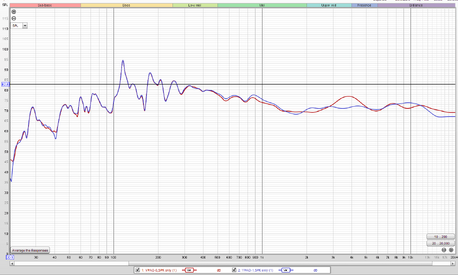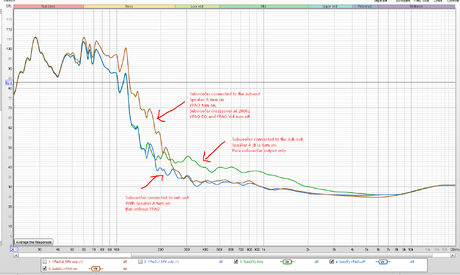- Manufacturer & Model
- Yamaha R-N803 Network Stereo Receiver
- MSRP
- $799
- Highlights
- Robust Amplifier Section, ESS Sabre DAC, High build quality, High Fidelity Sound, Extensive musical options through MusicCast app, Less then effective YPAO
- Summary
- The Yamaha R-N803 Network Stereo Receiver is, in many ways, all many need. A high-quality 2-channel amplifier with high-resolution DAC, high fidelity amplifier section, and feature-rich MusicCast app. It is astounding how good a sound can be achieved with just this receiver and a pair of high-end speakers. It could make an excellent centerpiece for an excellent 2-channel system, a really nice bedroom or office system, or anything in between. My biggest complaint was the DSP section and associated YPAO automatic setup and room correction often made things worse.
Two-channel receivers seem like a relic left over from a bygone era. In a world where every major home theater electronics manufacturer seems to offer so many receivers with so many options at every price point that a stereo receiver for $799 probably seems like a lost product. Why does it exist, and who is it for? Many music lovers primarily listen to music in just 2 channels. Experts in the home audio world will tell you that getting 2 channel right is far better than getting multi-channel wrong. Many rooms cannot support a properly setup home theater system, and if your needs lean more toward music, a stereo receiver may be a smarter buy. I have often found myself longing for an easy to use modern stereo receiver that allows for app control and a full suite of streaming services. The Yamaha R-N803, Yamaha’s flagship stereo network receiver with built-in MusicCast is this receiver. After more than six months of hands-on experience with this product, I can give you a true long-term introspection. After reading my review you will be reassured of Yamaha’s reliability and customer support.
Features
The Yamaha R-N803 network stereo receiver looks like a classic Yamaha. In fact, If I didn’t tell you it was a feature-packed network receiver, you might mistake this for a 30-year-old product, with classic Yamaha bar-style knobs and slab styling. To my eye, Yamaha has cast a nice balance between retro and modern style in providing an elegant piece of electronics. It isn’t minimalist by any means,
Inside the Yamaha, I noticed a massive transformer. No, it isn’t the toroidal transformers we lust after in audiophile products, but hey, what matters is how much current it delivers, and it’s clear this transformer has what it takes. In addition, I saw two large heatsinks running down the middle, large capacitors, and good quality parts. In fact, compare this to other mid-priced surround receivers and you will notice just how heavy this receiver is for having just two channels (24lbs, similar HT receivers come in at 20-30lbs). There are no HDMI boards, no 13 channels of amplification, large digital processors, that’s all amp
One of the unique features the Yamaha has, at least for a stereo receiver, is YPAO, Yamaha’s Parametric Acoustic Optimizer and Reflected Sound Control, or Automatic room compensation. I was excited to try Yamaha’s current version of YPAO. I had hoped it might provide a flatter/smoother bass response and make set up easy. In addition, it has a dedicated subwoofer output, along with bass management including distance controls for proper time alignment. I did not find YPAO particularly effective with any of the speakers I tried it on, and I ended up turning its EQ function off for all my listening. The distance control didn’t seem to work quite right for me, I found it inaccurately detected the amount of delay the subwoofers introduced and set the distance too low. I ended up using REW for my measurements and setup instead.
Finally, let’s focus on Yamaha MusicCast. The entire reason I asked Yamaha for this receiver is that I had been looking for a simple 2-channel receiver that I could use to review small bookshelf speakers, as well as something that would give me easier access to my favorite streaming apps. I spend most of my time listening to music stored on hard drives, streamed from Tidal, or played from my laptop. I previously reviewed NAD’s BlueSound BlueOS system and loved it. So much so I missed it and wished I had kept that wonderful integrated amp. I wanted to try a product that might provide similar fidelity at a lower price point, and honestly, wanted to see what the competition’s multiroom network streaming OS was like. I’ve used Sonos as well, but they didn’t offer a product that has the power
Setup
As I noted earlier, the Yamaha was easy to set up. It came packaged in a robust box identical to the boxes that Todd Anderson noted in his two prior Yamaha reviews. Once removed from the simple packaging and separating out the accessories, I got to setting it up. It came with a quick start guide, I glanced at it, and setup was a cinch. First, I put the Yamaha on an amplifier stand, hooked up the Outlaw Audio BLSv2 speakers, and powered everything on. I downloaded the Yamaha controller app, The MusicCast app, and worked on adding the Yamaha to my network. There are a number of ways to do this, with Direct WiFi being one of the simplest. This method connects the Yamaha directly to your phone temporarily, and then allows your phone to connect the Yamaha to your WiFi network. Once this is done you might want to consider using YPAO. As I will discuss later, I didn’t like it. It got the subwoofer distance wrong and was unable to compensate for delay in the subwoofer. The EQ didn’t seem to do much that I could measure, especially in the bass where it matters most. I could clearly hear the difference it made, but it wasn’t desirable and I chose to leave it off.
As for the review system, I used this product for quite a while before writing this review, so the speakers I had at my disposal were significant. Normally when a reviewer gets a product, they test it for a month or more, they test it out with their reference speakers and maybe one or two others. In my case, I had various speakers at my disposal that this became a neat opportunity to really see what the Yamaha can do. I’ll describe it’s sound later, but the speakers I tested included my Geddes Abbey 12’s, Outlaw Audio BLSv2, Klipsch Reference Premiere RP-280F, Philharmonic Audio BMR Philharmonitor, and the absolutely gargantuan JTR Noesis 212RT. The sensitivity and electrical load of all these speakers are all so different that it provided a great opportunity to really test the ability of the Yamaha amplifier to drive good speakers. The reality, for me at least, is that most good amplifiers sound the same. Whatever differences in sound may exist are often swamped by everything else going on. I paid the greatest attention to things like the amplifier's noise floor and the ability to drive a speaker without clipping too easily.
How did it sound
The Yamaha R-N803 in use was an absolute joy. First, MusicCast was nearly flawless. If my WiFi signal was strong or I used a wired network connection I rarely if ever experienced any dropouts. I did occasionally run into problems where the App wouldn’t log into my Tidal account, but typically resetting the receiver fixed it.
Philharmonic BMR Philharmonitor
Using the Yamaha with these BMR speakers was a really fun experience. What is most notable is that this setup consisted of the BMR speakers, a Martin Logan Subwoofer, and the Yamaha receiver, nothing else. That is just 3 components, and out of that, I had created a system that I felt provided stupendous fidelity, full bandwidth, wide dynamic range, neutral tonal balance, and reach out and touch it imaging. We are talking about $3,248 in retail worth of equipment providing sound that is nearly as good as it gets. The kind of systems that give me this level of sound often cost many times that amount.
The first album I really explored on this setup was the recently released Celebrating John Williams performed by the Los Angeles Philharmonic and conducted by Gustavo Dudamel. Many of you know John Williams as the brilliant composer behind the soundtrack to E.T., Star Wars, and countless other films. In this case, I focused on the E.T. track, “Adventures from Earth.” It’s a powerful piece with huge dynamics but also a real delicacy about it. By four minutes into the track the piece begins to slow down projecting a kind of sadness and wonderment. Through the BMR’s I felt the full scale of the orchestra was being well presented. Dynamics seemed more than adequate, though maybe not the equal of the best systems I’ve ever heard. I wouldn’t fault the Yamaha too much, the BMR’s are very inefficient and can’t handle a ton of power.
After that, I cued up the Theme from Jurassic Park. The composition was better than I realized musically, and I had great fun listening to it. Much like E.T., this is a very dynamic performance with big crescendos, while also having many delicate moments presenting just the horn section or string section here and there. The Yamaha/BMR combination was great, tonally accurate, imaging was strong, the scale was right on for the most part. The only distraction was
After this I put on one of my favorite classical guitar pieces, Suite Espanola, Op. 47: No. 4, Asturias (Leyenda) performed by John Williams. The quality of the DAC and amplifier in this receiver were good enough to give some
JTR Noesis 212RT
These speakers are special too. Jeff has become a friend of mine through this industry and his products are among the best value in the business. His speakers are big black boxes, not the gloss paint and wood veneer we are used to seeing with audiophiles. Yet these speakers do some things as well or better than any speaker I’ve heard. Their dynamics and imaging are second to none. With more than 100dB at 1 watt/1-meter sensitivity, they sure better be dynamic. While these speakers are very large and capable of handling a ton of power, their high sensitivity makes them an easy load to drive. You might think the Yamaha R-N803 is a strange pairing with the JTR, but there was great synergy. While the JTR can take more power, and some may want it, this setup was more than capable of producing volume levels that nobody should be listening at. A quick calculation of this setup suggests it is capable of more than 110dB of output at the listening position for each speaker. Meaning that at the end of the day, this little 100 watt per channel receiver with MusicCast and these giant Dual 12” MTM tower speakers created an all in three system capable of very loud and realistic volume levels. I could recreate any large orchestra piece, any organ piece, any rock concert with the realism I am used to hearing at live events. Further, I loved how simple this setup was. Just three components and three wires (Power and two speaker cables) are all I needed to create one of the best sounding systems I’ve ever heard in my life. I played the same tracks as I mentioned with the BMR’s and found much of the same. The Yamaha and JTR combination simply provided a larger presentation with even greater dynamics.
What about YPAO?
This receiver has Yamaha Parametric room Acoustic Optimizer with reflected sound control. I had hoped this newer version of YPAO would address my past negative feelings, but unfortunately, Yamaha still has work to do. This system, both measurably and subjectively, made things worse. I wanted to believe in YPAO. I tried setting it up and engaging it repeatedly. But I never did
Competition
In some ways the competition for this receiver is vast. First, for it’s selling price, any number of mid-range home theater receivers provide similar features, power, and networking capabilities. What differentiates the Yamaha from these products is the high-end DAC and the high-quality amplifier. The Yamaha has a power supply that is easily as large or larger than any I have seen in a modern 7+ channel receiver, but it is only powering two channels. When comparing it to my own Onkyo receiver, I found the Yamaha never audibly clipped nor had any trouble driving any of my speakers. The Onkyo occasionally had some hiccups, with noticeable hardening, compression, and audible clipping during some dynamic music and movie moments. As such, I don’t really consider home theater receivers to be true competition. They might offer better value, but there is a compromise in sound quality.
Which brings us to one of the few products on the market that is true competition. The Outlaw Audio RR2160. I haven’t had this receiver in my own system yet, but I have used it a handful of times. What I can say is that the Outlaw is an over-achiever. At $849 you get a lot of amplifier for the money, even compared to the Yamaha which sells for $749. While rated at a similar 110 watts, I think the Outlaw is more conservatively rated than the Yamaha. The main difference is that the Outlaw Audio is not a networked receiver with app control. It doesn’t have built-in apps like Tidal. It is expensive and difficult for small companies to develop these systems, which is a big loss. I have found such features so central to my musical enjoyment that I consider
What about the NAD C-368 I previously reviewed? The NAD is better. Sorry Yamaha, but it’s true. It is better in every way. It is smaller, better built, is just as powerful, has an equal or better DAC, and superior streaming software. I like Blue Sound better. Additionally, I like the interface, usability, and available streaming apps. Plus, the Yamaha can’t stream Tidal at HD quality (MQA), but Blue Sound can. However, the NAD is $1199 when equipped with the BluOS module, making it quite a bit more expensive. The NAD is not twice as good as the Yamaha. Both can serve as the centerpiece of an amazingly high-fidelity system at a surprisingly low total cost. Some of you may think these comments are out of touch, that $749 is a lot of money for a stereo receiver and that $1199 is an insane amount of money for an integrated amplifier. I understand where you are coming from, this is still a lot of money. But gear has gotten to a point today where its technical and subjective performance rivals what used to cost more like $10,000.
Conclusion
I’ve really enjoyed my time with the Yamaha R-N803. It’s a great network connected receiver offering a compelling set of features, high build quality, and good sound. The receiver always acquitted itself well amongst the many different speakers I tried it with and became the centerpiece of many wonderful listening sessions. The Yamaha R-N803 Network receiver is supremely neutral in tonal balance. What you get with the Yamaha is an all in one audiophile package. The quality of the DAC, amplifier, preamplifier, and most importantly, MusicCast system is among the best I have seen for this price point. For more than half a year it was the centerpiece in many speaker shootouts and listening sessions. It put a smile on the face of many jaded reviewers, including myself. I love how easy it is to put together a truly outstanding high-resolution system from such a simple set of products. This receiver connected to the Philharmonic BMR Philharmonitor’s is probably among the best sounding systems I have ever heard. Yet the total cost of entry and lack of complexity was astonishing. For those looking for a network-connected two-channel receiver, I truly recommend the Yamaha.
Yamaha R-N803 Network Stereo Receiver Specifications
- RMS Output: 100 watts per channel (8 ohms, 20hz-20khz, .019% THD)
- Signal to Noise Ratio: 100 db
- Audio Input/output: 10/2
- Input Type: Optical digital, Coaxial digital, RCA, USB, Phono
- Output: Subwoofer
- Digital Media Formats: DLNA v1.5, MP3, WMA, MPEG4, AAC, WAV, FLAC, AIFF, ALAC, DSD, Bluetooth (SBC/AAC)
- WiFi: Yes with direct mode
- Dimensions: 17 1/8" x 15 7/16"
- Weight: 24.3 lbs
Last edited by a moderator:










